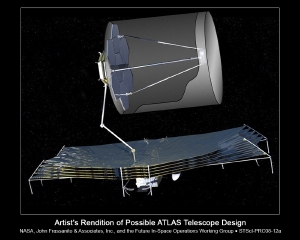Feb 16 2008
Two astronomers at the Space Telescope Science Institute (STScI) in Baltimore, Md., Dr. Marc Postman and Dr. Ken Sembach, have been selected among 19 science teams to conduct year-long studies of new concepts for NASA's next generation of major observatories. The studies will help the agency make decisions about how it explores the heavens in the future, following the Astronomy and Astrophysics Decadal Survey.
 This is an artist's rendition of a possible ATLAS telescope design.
This is an artist's rendition of a possible ATLAS telescope design.
Postman's group will study the feasibility of building the Advanced Technology Large-Aperture Space Telescope (ATLAS Telescope), which will have more than 40 times the sensitivity of the Hubble Space Telescope. The telescope would have a primary mirror that could be as large as 16 meters in diameter, and could be carried aboard NASA's planned Ares V heavy-lift launch vehicle. The telescope would be located 1 million miles away at a gravitational balancing point in space called L2, where the James Webb Space Telescope will be perched when it is launched in 2013.
"The ATLAS telescope will revolutionize astronomy. It will enable us to definitively answer the question: 'Are there life-bearing Earth-like planets in our Galaxy?' Postman said. "It will allow us to map the dark matter around galaxies in unprecedented detail, giving us fundamentally new insights into how structure in the universe develops over time. And it will allow us to detect individual Sun-like stars in galaxies as far away as 30 million light-years, allowing us to reconstruct the assembly histories of 20 times as many galaxies as we can do with current telescopes. The primary goal of our study is to identify a path to developing the key technologies that we need to bring us to a state-of-the-art that, in ten years from now, will allow us to build a telescope much more powerful than Hubble but at similar cost."
Ken Sembach's team will study the feasibility of adding ultraviolet spectrographs to large space telescopes. This novel instrumentation will bolster observational cosmology by examining the "cosmic web" in much greater detail than is possible with Hubble or the Far Ultraviolet Spectroscopic Explorer. This web is made up of great filaments of dark matter which interacts with the evolution of stars and galaxies. Observations of the cosmic web will provide fundamental tests of cosmological theory.
"Our goal is to reduce the cost of future NASA missions by producing novel instrument designs and a roadmap for investments in enabling technologies at ultraviolet wavelengths," Sembach said. "We expect that such investments will revolutionize studies of the filamentary cosmic web of tenuous gas that surrounds and connects galaxies."
Every 10 years, astronomers and physicists from across the U.S. work with the National Academy of Sciences to define the future research directions for the fields of astronomy and astrophysics. The science teams' work is part of an effort to ensure that technical and cost input is accurate for this upcoming Astronomy and Astrophysics Decadal Survey. The survey produces directions that guide federal agencies such as NASA and the National Science Foundation in planning their programs over the coming decade.
"Astrophysics is truly in a golden age, revolutionizing our knowledge of topics as diverse and compelling as the origin and evolution of the universe, the physics of black holes and the distribution and habitability of planetary systems across our galaxy," said Alan Stern, associate administrator for the Science Mission Directorate at NASA Headquarters, Washington. "The exciting new astrophysics mission concept studies we are funding will seed preparations for astronomical space missions and paradigm-shifting discoveries across the early 21st century. Today, NASA's Science Mission Directorate is setting sail on a whole new chapter in continued U.S. leadership in astrophysics."
The concept studies total approximately $12 million in fiscal years 2008 and 2009, ranging in cost from $250,000 to $1 million.
"The number, range, and quality of the proposals submitted indicate very powerfully the level of enthusiasm in the community for addressing frontier astrophysics research and employing the very latest technologies," said Jon Morse, division director for Astrophysics, NASA Headquarters. "This early investment directed toward the decadal study will pay off in the coming years."
The studies' results are expected in March 2009. Concepts that rank highly in the decadal survey may result in missions that would launch after the suite of missions in development, such as the Gamma-ray Large Area Space Telescope, scheduled o launch in May, the Kepler mission, scheduled to launch in 2009, and the James Webb Space Telescope, scheduled to launch in 2013.
Postman is a senior astronomer at STScI and head of the Institute's Community Missions Office, which provides science operations support for a number of additional missions and projects including the data management center for the Kepler Mission and the data archive center for all of NASA's optical/ultraviolet missions.
Sembach is currently the STScI's Hubble Project Scientist, a position in which he is deeply involved in the scientific, operational, and managerial aspects of the Hubble Space Telescope.